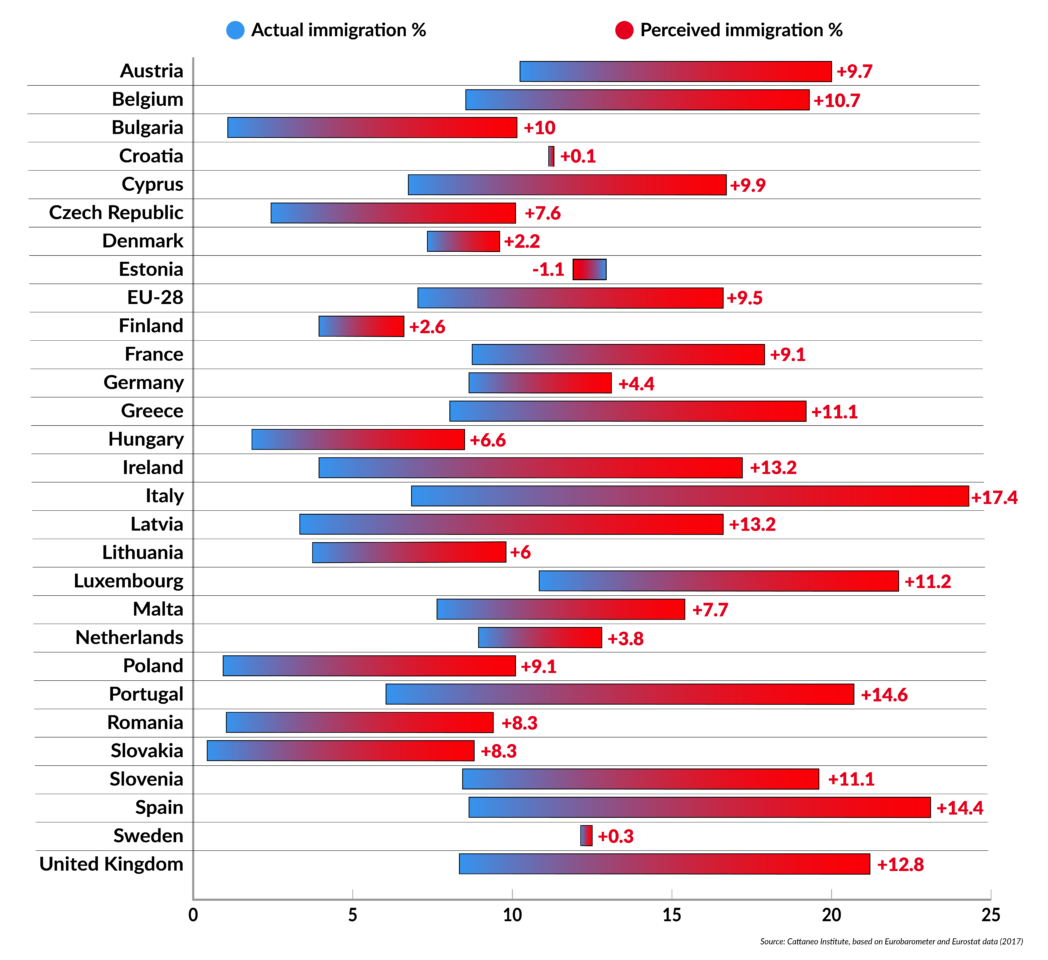Will immigration sink the EU?
At the root of the problem is its inability to integrate poorly educated, low-skilled individuals into workforces. Introducing measures to help debureaucratize labor markets, reform education and punish criminals would help solve preexisting problems that immigration has only put in the spotlight.

In a nutshell
- Immigrants do not make up a large proportion of most EU countries’ populations
- Yet the immigration issue threatens to tear the bloc apart
- The main difficulty is integrating low-skilled people into the workforce
- It is unlikely that European leaders will choose to solve this problem
The European Union’s current weakness is beyond dispute. It has failed to develop its own foreign and defense policies, is unable to enforce its own treaties and finds it difficult to eliminate its mercantilist features, like the common agricultural policy and protectionist regulations. To top it off, the eurozone suffers from periodic crises. Sadly, an EU meeting is now considered successful when it avoids major clashes. Yet despite all these flaws, the biggest risk to the bloc lies in immigration.
Among large European countries, the number of non-EU foreign residents is significant, but not enormous. For example, in January 2017 immigrants comprised 6.3 percent of the population in Germany and 5.8 percent in Italy. The average for the entire EU was also 5.8 percent. Of course, to get a better picture, one should also take into account nonresident legal immigrants and illegal immigrants. Doing so would probably raise the preceding figures by another percentage point.
These numbers deserve attention, especially because immigration has accelerated over the past five years. Because immigrants often concentrate in certain areas, the influx can drastically alter local culture. Nonetheless, less than 7 percent of the bloc’s population is a relatively modest total. This raises the question of why immigration has become a burning political problem in the first place. The answer might suggest strategies the EU could adopt to resolve it.
The problem is the inability to integrate low-skilled individuals into modern production processes.
In general, immigrants make headlines when they engage in violent crime or become a heavy burden on the welfare state, especially in countries where public finances are fragile. Unsurprisingly, these phenomena become particularly acute when politicians try to exploit the issue of immigration to promote their own political fortunes in the short term.
The problem is not immigration by itself. Rather, it is the inability of advanced market economies to integrate poorly educated, low-skilled individuals in modern production processes, as well as to sanction criminal behavior effectively. Although these two issues are a source of serious trouble, they do not stem from immigration. Nonetheless, it is easy and expedient to blame immigrants and sweep under the rug the real problems: a failure to recognize signals from the labor market, an unwillingness to reform the welfare state, and an inability to punish violent criminal behavior. Policymakers’ commitment to addressing these faults will determine how the issue of immigration will evolve.
Risks of inaction
In one potential scenario, politicians would choose to do nothing. This would likely lead the EU toward further tensions and possibly disaster. Technological progress shows that production needs highly skilled workers in manufacturing and selected services (such as finance). Motivation and a sense of individual responsibility also play a major role, and sometimes can compensate for inadequate skills. Thus, those who meet these requirements get reasonably well-paid jobs both in the high-skill and the low-skill segments of the labor market, while the rest of the labor force ends up marginalized and eventually appeals to the welfare state.
Facts & figures
Immigration in the European Union: difference between reality and perception (2017)
Actual percent of immigrants from non-EU countries (Eurostat) and perceived (Eurobarometer), difference in percentage points

Regrettably, many European leaders continue to believe that the answer to unemployment is regulation and that the answer to poverty is redistribution. As a result, many European countries have high levels of both unemployment and poverty, and plenty of unfilled vacancies. Immigrants entering the EU – say, from Africa or the Middle East – epitomize this situation. Most of them badly need to learn the language of their host country, and to find an environment that provides them with the suitable incentives (motivation) and possibly good quality education for their children. Falling back on the welfare state should remain a remote possibility, while criminal activity should involve immediate and severe sanctions.
Will Europe wake up to these needs? Probably not, since most European countries are unwilling to reform their education systems and fear the consequences of deregulating the labor market. If this pessimistic prediction comes true, both native residents and immigrants will fall victim to institutional inertness, while immigrants will find integration all but impossible, and crime more acceptable.
Rising tension
Of course, complaining about immigrants will not solve the problem. Instead, it will create tension within the Union in at least three different ways. First, since political leaders in some EU countries tend to believe that the best answer to immigration is getting rid of the immigrants, the pressure to develop a European policy against immigration will mount. Brussels will be unable to deliver, EU authorities will lose credibility and local populist demands will increase.
Italy’s leaders are essentially asking for special funds to deal with immigration or for permission to violate EU rules.
Second, some countries will try to take advantage of the EU’s weakness and offer to remain silent in exchange for benefits in other areas. Italy provides the most recent example of this strategy. Its leaders are essentially asking for special funds to deal with immigration or for permission to violate EU budgetary rules. In exchange, Italians would refrain from dumping immigrants on other EU countries. This attitude will elicit different responses, but Brussels’ inanity will be evident.
Third, the inability of large countries to transform immigration into an asset might encourage advocates of decentralization. They propose that each country would admit immigrants only if authorities at a regional level (for example) accept them. If this were to happen, pressure would build up to decentralize the nationwide welfare state, or at least some elements of it. This outcome is more likely in countries where the central government is split on the issue of immigration, while local governments are more politically homogeneous.
Put them to work
A different scenario would emerge if EU authorities introduced legislation applying to all nonresidents regardless of origin, or at least to all non-EU residents. Populist feeling would probably make it difficult for national governments to legislate in this direction. Yet, it would probably be different if the proposal came from Brussels and translated into European directives that would allow free contracting (deregulation and debureaucratization) in the labor market, and possibly introduce severe punishment for violent behavior.
Such legislation would take immigrants out of the jobless limbo in which they are currently relegated for months or years until their status is defined, and give them a serious incentive to integrate into the host country’s society. At the same time, national governments would have a solid argument for sanctioning them if they broke the rules. One can easily imagine that the EU would be criticized for introducing “neoliberal” principles into highly regulated economic systems. However, such efforts would shape a new role for EU policymakers.
Europe suffers from a highly regulated labor market and an education system that reflects bureaucrats’ preferences.
Europe suffers from a highly regulated labor market and an education system that tends to reflect bureaucrats’ preferences, rather than the needs of a rapidly evolving economic system. Unskilled workers are most vulnerable to these distortions and are likely to rely more and more on the welfare state. Immigrants from undeveloped countries add to the difficulties and draw attention to issues that are already on the table. Nationalistic reactions are understandable, but do not offer a viable solution. They only make the problem worse.
Inadequate response
If the EU pursues the “do-nothing” option, it will be forced to make budgetary concessions or tolerate violations in favor of the most vociferous members. The issues raised by immigration will not be addressed. Indeed, the phenomenon will become an excuse to avoid the challenges presented by technological change. Budgetary slack might avoid the moment of reckoning in some countries, but it will just be a matter of time before crisis breaks out.
Regrettably, EU policymakers are molded by a deeply embedded regulatory culture, which puts them at a disadvantage whenever a different mind frame is required. Immigration is one of those situations. Sooner or later, politicians will toughen their stance on crime. It is lamentable that this will happen not to bolster the rule of law and the principles of individual responsibility, but as a result of nationalistic populism and hopes of preserving the welfare state in its current form.







